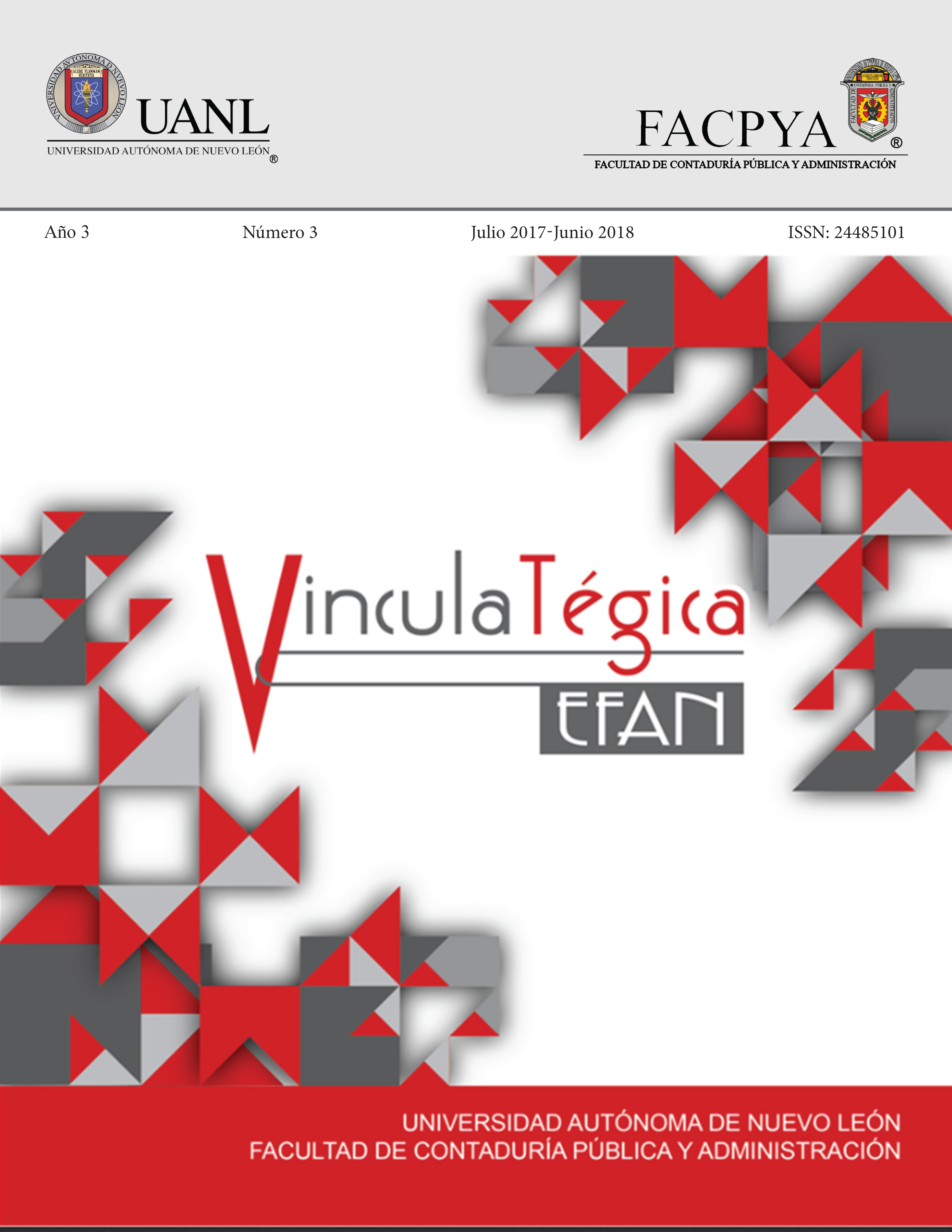El rol de la innovación en la toma de decisiones de marketing en la industria cervecera mexicana
DOI:
https://doi.org/10.29105/vtga3.3-949Keywords:
innovación, capacidad de absorción, cerveza, toma de decisiones, marketingAbstract
The decision-making process is key to driving an advantage in companies, it requires several factors to be able to carry out this process efficiently. One of the variables that is implicated in this process is the absorption capacity of the company, which allows it to obtain knowledge or develop it to drive innovation in the process of decision-making in the marketing area. In the Mexican brewing sector, this process is experienced daily and it is of vital importance to be able to make the best decisions in this closed and competitive market. This article exposes the mediating role of innovation between the absorption capacity and the decision-making in the area of marketing.
Downloads
References
Ansoff, H., & MacDonnell, E. (1990). Implanting strategic management (1st ed.). New York [u.a.]: Prentice Hall.
Barton, D. and D. Court. 2012. Making advanced analytics work for you: A Practical guide to capitalizing on big data. Harvard Business Review (October): 78-83.
Cohen, W., & Levinthal, D. (1990). Absorptive Capacity: A New Perspective on Learning and Innovation. Administrative Science Quarterly, 35(1), 128. DOI: https://doi.org/10.2307/2393553
Diario NTR (2015). Heineken presume http://www.ntrguadalajara.com/post.php?id_nota=16057 sus procesos de innovación.
Digman, L.A. (1986). Strategic Management Concept, Decisions Cases. Texas: Business Publication inc
Edmonson, A., & Mcmanus, S. (2007). Methodological fit in management field research. Academy Of Management Review, 32(4), 1155-1179. DOI: https://doi.org/10.5465/amr.2007.26586086
Eisenhardt, K., & Graebner, M. (2007). Theory building from cases opportunities and challenges. Academy Of Management Journal, 50(1), 25-32. DOI: https://doi.org/10.5465/amj.2007.24160888
Gamble, J., & Thompson, A. A. (2011). Essentials of strategic management: The quest for competitive advantage. New York: McGraw-Hill Irwin.
Gardner, H. (1993). Frames of mind: The theory of multiple Intelligences (2ª ed.). Nueva York: Basic Books.
Haller, C., Amabile, S., Meissonier, R., & Boudrandi, S. (2012). Business Intelligence and Absorptive Capacity of Information by Wineries in the Provence Wine Industry. International Business Research, 6(2). DOI: https://doi.org/10.5539/ibr.v6n2p126
Hurley, R., & Hult, G. (1998). Innovation, Market Orientation, and Organizational Learning: An Integration and Empirical Examination. Journal Of Marketing, 62(3), 42. DOI: https://doi.org/10.2307/1251742
Johnson G. & Scholes K. (2001). Dirección estratégica. (5a Ed.). Madrid: Prentice Hall.
Knight, G., & Cavusgil, S. (2004). Innovation, organizational capabilities, and the born-global firm. Journal Of International Business Studies, 35(2), 124-141. DOI: https://doi.org/10.1057/palgrave.jibs.8400071
Lane, P., & Lubatkin, M. (1998). Relative absorptive capacity and interorganizational learning. Strategic Management Journal, 19(5), 461-477. http://dx.doi.org/10.1002/(sici)1097-0266(199805)19:5%3c461::aid-smj953%3e3.3.co;2-c DOI: https://doi.org/10.1002/(SICI)1097-0266(199805)19:5<461::AID-SMJ953>3.3.CO;2-C
Lev, S., Fiegenbaum, A., & Shoham, A. (2009). Managing absorptive capacity stocks to improve performance: Empirical evidence from the turbulent environment of Israeli hospitals. European Management Journal, 27(1), 13-25. DOI: https://doi.org/10.1016/j.emj.2008.04.001
Lewandowska, M. (2015). Capturing Absorptive Capacity: Concepts, Determinants, Measurement Modes and Role in Open Innovation. International Journal Of Management And Economics, 45(1). DOI: https://doi.org/10.1515/ijme-2015-0015
Marketin Directo (2016). 7 lecciones aprendidas de Heineken para conquistar a los consumidores. Recuperado de https://www.marketingdirecto.com/marketing-general/marketing/7-lecciones-aprendidas-heineken-conquistar-consumidores
Mason, R.O. & Mitroff, I.I. (1981). Challenging Strategic Planning Assumptions. New York: Wiley.
Neustadt, R & May, E. (1986). Thinking InTime. N.Y: Free Press.
Payeras, M. (2013). ¿Está su empresa lista para una iniciativa de big-data? Recuperado de http://www.empresas.it.
Pearce, J., & Robinson, R. (2013). Strategic management (1st ed.). New York: McGraw-Hill Higher Education.
Perks, H. (2001). Marketing information exchange mechanisms in collaborative new product development: the influence of resource balance and competitiveness. Journal Of Product Innovation Management, 18(2), 126. DOI: https://doi.org/10.1016/S0737-6782(01)00086-8
Quinn, J.B. (1980). Strategic Change: Logical Incrementalism. Homewood IL: Richard D. Irwin
Schwenk, C.R. (1988). The Essence of Strategic Decision-making. Lexington. MA: Lexington Books
Shang, J., Yildirim, T., Tadikamalla, P., Mittal, V., & Brown, L. (2009). Distribution Network Redesign for Marketing Competitiveness. Journal Of Marketing, 73(2), 146-163. DOI: https://doi.org/10.1509/jmkg.73.2.146
Slater, S., Mohr, J., & Sengupta, S. (2013). Radical Product Innovation Capability: Literature Review, Synthesis, and Illustrative Research Propositions. Journal Of Product Innovation Management, 31(3), 552-566. DOI: https://doi.org/10.1111/jpim.12113
Susana Marques, C., & Monteiro‐Barata, J. (2006). Determinants of the Innovation Process: An Empirical Test for the Portuguese Manufacturing Industry. Management Research: Journal Of The Iberoamerican Academy Of Management, 4(2), 113126. DOI: https://doi.org/10.2753/JMR1536-5433040203
Torrecillas, C. (15 abril 2017) Entrevista con Citlali Torrecillas. Recuperado de audio mp3.
Yin, R. K. (2003). Case study research: Design and methods. Thousand Oaks, Calif: Sage Publications.
Zafer Erdogan, B., & Uzkurt, C. (2010). Effects of ethnocentric tendency on consumers' perception of product attitudes for foreign and domestic products. Cross Cultural Management: An International Journal, 17(4), 393-406. DOI: https://doi.org/10.1108/13527601011086595
Zahra, S., & George, G. (2002). Absorptive Capacity: A Review, Reconceptualization, and Extension. The Academy Of Management Review, 27(2), 185. DOI: https://doi.org/10.2307/4134351
Downloads
Published
How to Cite
Issue
Section
License

This work is licensed under a Creative Commons Attribution 4.0 International License.
a). Authors keep copyright and give the journal the right of the first publication of the work under a Creative Commons attribution license. This license allows others to share the work as long as original authorship and initial publication in this journal is acknowledged.
b). Authors may make other independent and additional contractual agreements for the non-exclusive distribution of the version of the article published in this journal (e.g., include it in an institutional repository or publish it in a book) as long as they clearly indicate that the work was published for the first time in this journal.







